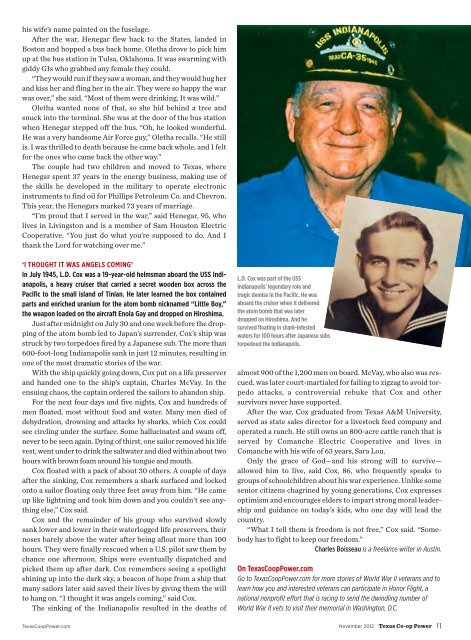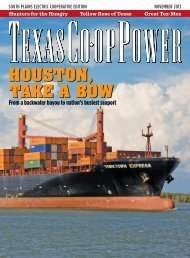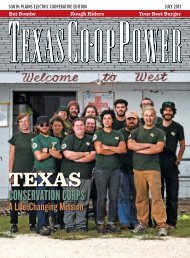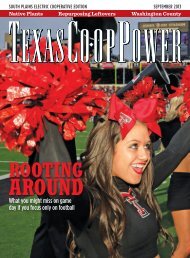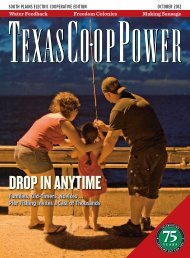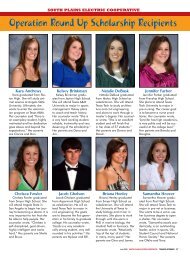November 2012PDF 5.57 MB - South Plains Electric Cooperative
November 2012PDF 5.57 MB - South Plains Electric Cooperative
November 2012PDF 5.57 MB - South Plains Electric Cooperative
You also want an ePaper? Increase the reach of your titles
YUMPU automatically turns print PDFs into web optimized ePapers that Google loves.
his wife’s name painted on the fuselage.<br />
After the war, Henegar flew back to the States, landed in<br />
Boston and hopped a bus back home. Oletha drove to pick him<br />
up at the bus station in Tulsa, Oklahoma. It was swarming with<br />
giddy GIs who grabbed any female they could.<br />
“They would run if they saw a woman, and they would hug her<br />
and kiss her and fling her in the air. They were so happy the war<br />
was over,” she said. “Most of them were drinking. It was wild.”<br />
Oletha wanted none of that, so she hid behind a tree and<br />
snuck into the terminal. She was at the door of the bus station<br />
when Henegar stepped off the bus. “Oh, he looked wonderful.<br />
He was a very handsome Air Force guy,” Oletha recalls. “He still<br />
is. I was thrilled to death because he came back whole, and I felt<br />
for the ones who came back the other way.”<br />
The couple had two children and moved to Texas, where<br />
Henegar spent 37 years in the energy business, making use of<br />
the skills he developed in the military to operate electronic<br />
instruments to find oil for Phillips Petroleum Co. and Chevron.<br />
This year, the Henegars marked 73 years of marriage.<br />
“I’m proud that I served in the war,” said Henegar, 95, who<br />
lives in Livingston and is a member of Sam Houston <strong>Electric</strong><br />
<strong>Cooperative</strong>. “You just do what you’re supposed to do. And I<br />
thank the Lord for watching over me.”<br />
‘I THOUGHT IT WAS ANGELS COMING’<br />
In July 1945, L.D. Cox was a 19-year-old helmsman aboard the USS Indianapolis,<br />
a heavy cruiser that carried a secret wooden box across the<br />
Pacific to the small island of Tinian. He later learned the box contained<br />
parts and enriched uranium for the atom bomb nicknamed “Little Boy,”<br />
the weapon loaded on the aircraft Enola Gay and dropped on Hiroshima.<br />
Just after midnight on July 30 and one week before the dropping<br />
of the atom bomb led to Japan’s surrender, Cox’s ship was<br />
struck by two torpedoes fired by a Japanese sub. The more than<br />
600-foot-long Indianapolis sank in just 12 minutes, resulting in<br />
one of the most dramatic stories of the war.<br />
With the ship quickly going down, Cox put on a life preserver<br />
and handed one to the ship’s captain, Charles McVay. In the<br />
ensuing chaos, the captain ordered the sailors to abandon ship.<br />
For the next four days and five nights, Cox and hundreds of<br />
men floated, most without food and water. Many men died of<br />
dehydration, drowning and attacks by sharks, which Cox could<br />
see circling under the surface. Some hallucinated and swam off,<br />
never to be seen again. Dying of thirst, one sailor removed his life<br />
vest, went under to drink the saltwater and died within about two<br />
hours with brown foam around his tongue and mouth.<br />
Cox floated with a pack of about 30 others. A couple of days<br />
after the sinking, Cox remembers a shark surfaced and locked<br />
onto a sailor floating only three feet away from him. “He came<br />
up like lightning and took him down and you couldn’t see anything<br />
else,” Cox said.<br />
Cox and the remainder of his group who survived slowly<br />
sank lower and lower in their waterlogged life preservers, their<br />
noses barely above the water after being afloat more than 100<br />
hours. They were finally rescued when a U.S. pilot saw them by<br />
chance one afternoon. Ships were eventually dispatched and<br />
picked them up after dark. Cox remembers seeing a spotlight<br />
shining up into the dark sky, a beacon of hope from a ship that<br />
many sailors later said saved their lives by giving them the will<br />
to hang on. “I thought it was angels coming,” said Cox.<br />
The sinking of the Indianapolis resulted in the deaths of<br />
L.D. Cox was part of the USS<br />
Indianapolis’ legendary role and<br />
tragic demise in the Pacific. He was<br />
aboard the cruiser when it delivered<br />
the atom bomb that was later<br />
dropped on Hiroshima. And he<br />
survived floating in shark-infested<br />
waters for 100 hours after Japanese subs<br />
torpedoed the Indianapolis.<br />
almost 900 of the 1,200 men on board. McVay, who also was rescued,<br />
was later court-martialed for failing to zigzag to avoid torpedo<br />
attacks, a controversial rebuke that Cox and other<br />
survivors never have supported.<br />
After the war, Cox graduated from Texas A&M University,<br />
served as state sales director for a livestock feed company and<br />
operated a ranch. He still owns an 800-acre cattle ranch that is<br />
served by Comanche <strong>Electric</strong> <strong>Cooperative</strong> and lives in<br />
Comanche with his wife of 63 years, Sara Lou.<br />
Only the grace of God—and his strong will to survive—<br />
allowed him to live, said Cox, 86, who frequently speaks to<br />
groups of schoolchildren about his war experience. Unlike some<br />
senior citizens chagrined by young generations, Cox expresses<br />
optimism and encourages elders to impart strong moral leadership<br />
and guidance on today’s kids, who one day will lead the<br />
country.<br />
“What I tell them is freedom is not free,” Cox said. “Somebody<br />
has to fight to keep our freedom.”<br />
Charles Boisseau is a freelance writer in Austin.<br />
On TexasCoopPower.com<br />
Go to TexasCoopPower.com for more stories of World War II veterans and to<br />
learn how you and interested veterans can participate in Honor Flight, a<br />
national nonprofit effort that is racing to send the dwindling number of<br />
World War II vets to visit their memorial in Washington, D.C.<br />
TexasCoopPower.com <strong>November</strong> 2012 Texas Co-op Power 11


